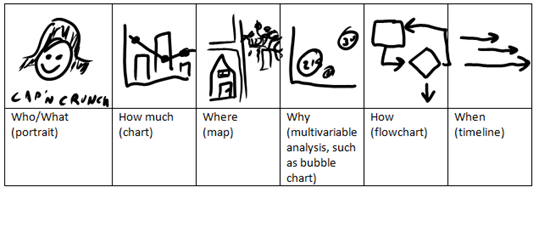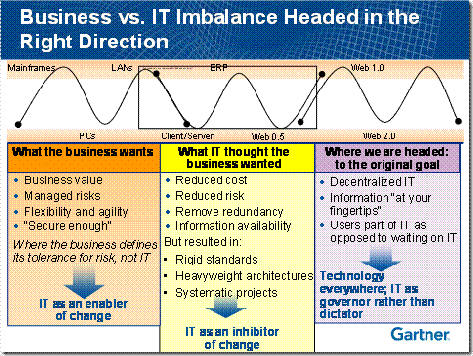Trip Report : Day Two of Gartner BPM Conference
Hi Marius here again with highlights from day 2 of the Gartner BPM conference.
Back of the Napkin
You may have heard of the book called The Back of the Napkin: Solving Problems and Selling Ideas with
Pictures. It’s one of the latest books creating a buzz in business community. Dan Roam, the author
of the book presented on how the most daunting business problems can be described simply using
only stick figures in the space of a few square inches available on the back of a napkin. Ultimately,
those who present the problem the best get the funding to proceed with their project. Dan argues that
there are three types of people. Those who immediately jump to the whiteboard and start sketching
in meetings (25% of us), those who are not artistic BUT will highlight what’s interesting (50% of us), and
finally those who are not artistic and simply refuse to participate in the process (the remaining 25%).
Those who highlight don’t come up with new ideas, but they are good at dissecting ideas presented to
them and highlight what really matters. Those who refuse to sketch do so because they understand
that what’s being drawn is far too simplistic to be reality. These people tend to have the most facts on
the problem. When they compare the drawings to their own information, they are turned away from
the conversation. The challenge is to find a way to involve these people, and the solution presented
was to (don’t read if you’re this last type ;-) ) to get them angry enough at the situation that they take
control, cross out the irrelevant information, and find a way to distill their facts into a way that fits onto
the drawing. Dan argues that visual communication transcends language and cultural barriers and can
be used to communicate complex ideas – but these ideas need to be transformed into a combination
of the following: who/what, how much, where, why, how, and when. After talking a bit about
neurobiology, Dan explains that the brain has different visual pathways for each of these types of
information that are all processed in parallel. How can you present each type of information visually?
Just follow this chart:
The story given was that Dan had to present the problem statement around a financial process in
Microsoft. He drew the problem statement on paper using stick figures and didn’t manipulate
the image through Illustrator or any such tool. The execs were impressed because he was able to
easily relate to them and they asked what software he used. Facetiously he replied “Pen and Paper
1.0.” The moral of the story however, is that the more human your presentation, the more human the
response will be.
Next time you need to speak to your customer about pain points, try the following Wong-Baker pain
chart, used in emergency rooms:
BPM Modeling
The next session was about BPM modeling by one of the leaders of the BPMN standard. BPMN is a
powerful standard that can be used to model almost any business scenario. It is an easy to use way to
draw processes designed to be understood and used by business users. It’s limitations include not
being able to model meetings (without resorting to an ad-hoc task) and serializing the model.
Serializing is necessary to be able to save the model in a way that is executable by a workflow engine.
Workarounds to the serialization issue are to export the model as XPDL or BEPL. Despite these issues
BPM vendors are retrofitting their tools to support BPMN 1.1 due to its power in modeling processes
and simplicity for business users. Want to give BPMN for a spin? Try the free tool:
https://bizagi.com/eng/products/ba-modeler/desc-efective.html
Risk Management and Compliance
This was the one must see track session considering what our team does and I had to trade off several other
good presentations to attend this one. The key point delivered was that GRC is a short-term audit-driven need.
Nobody likes compliance (except for those whose jobs are compliance) but thanks to the likes of
Enron and MCI WorldCom we’re in an ever increasing regulatory environment where imposed
regulations continue to grow. Businesses really wants performance and business risk management but
for now they are faced with immediate needs to track regulatory compliance. GRC tools out there
include some form of process, but they are still stovepipe applications. In the next 4-8 years, expect to
see BPM solutions move into the GRC space. Strengths of BPM in the GRC space are the fact that you
can set risk management workflows, perform policy mapping, model (and simulate) risks and controls,
automate controls, and analyze control effectiveness. In our experience, creating management
workflows and analysis of control effectiveness are some of the hot topics in the risk management
work. The weaknesses of BPM in the GRC space is related to domain knowledge and time to
implement. The primary drivers of GRC implementations today are the need for domain knowledge of
regulatory standards (something that BPM vendors do not have experience in) and a quick audit-
driven solution – customers need a fast solution, not tools that enable them to create solutions. Since
“pure” GRC is a short-term need, the industry will begin to focus more on risk management, and
eventually business performance management. Since BPM is already in the realm of performance
management, the prediction is that BPM suites will start to include risk management and modeling
capability with compliance built-in to ensure that processes created through the tool are in
compliance.
User Interface and Empowerment Disrupts Business Applications
From the start, it was a surprise to see how few people attended the keynote on user interfaces.
Rather, most attended the session on change management instead. Since my double was not available
at the time, I had to pick one or the other and went to the only session related to UX. The problem
statement presented is that the returns on automation are shrinking, mostly due to the fact that business
applications have already squeezed the people out of processes in most places. Many of the
remaining tasks end up being non-routine, highly cognitive, and interactive tasks—and this trend is
growing. In second place are non-routine, highly cognitive, analytic tasks. Both of these types of tasks
are poor candidates for process automation. What should IT to do in these areas? Industry wide, IT is
already being seen as an inhibitor to business change.
The answer is to model processes around business KPIs (not the opposite) and empower the business
user to have information at their fingertips and to “design” their own solution:
• Focus on End-User Flexibility
- Enable end-user process flow design
- Enable end-user-driven creation of apps through configurations, personalization,
mashups, compositions
• Develop a Consumer like Experience
- Embedded user experience that includes Web 2.0 and user productivity like
experience
- Immersive UI, pervasive mobility
• Incorporate Context Into Processes
- Peer-based, ad hoc collaboration enabled
- Community-generated content
- Process and information design presented based on individual need
• Include a Network-Centric Design
- Anyone can participate, from any organization, from any geography
- Architected for high-volume, highly distributed, simultaneous connections
- Information can originate from anyone, anywhere — no boundaries
• Provide Actionable, Intelligent Insights
- Predictive, proactive and context-aware analytics
- External and internal cross-application content
- Structured and unstructured data analysis/synthesis
In the end this is really the people component of people, process, and technology.
Thanks for reading, more tomorrow.
Marius
Comments
- Anonymous
September 11, 2008
PingBack from http://hoursfunnywallpaper.cn/?p=5858 - Anonymous
September 25, 2008
BPMN is very useful at illustrating where there are key controls, automated controls and manual controls within a business process and at helping to remove repetition, increase automation and calculate ROI on risk control and insurance.I have used BPMN in anger to do this onsite at clients responding to auditor requirements.I dont agree that GRC is a short term need - its becoming part of a new discipline 'Technology Risk' and at companies where the audit, finance and compensation committees are well established we are starting to see 'Technology Risk' committees. This is happening with tangental involvement from Information Security because risk management is seen as enabling the business and security still suffers from a reputation of fighting it.


